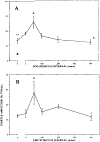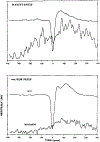Facilitation of the acoustic startle reflex by ponto-geniculo-occipital waves: effects of PCPA
- PMID: 2149298
- PMCID: PMC9148914
- DOI: 10.1016/0006-8993(90)91765-9
Facilitation of the acoustic startle reflex by ponto-geniculo-occipital waves: effects of PCPA
Abstract
The relationship between ponto-geniculo-occipital (PGO) waves and motor activity during waking and non-rapid eye movement (non-REM) sleep stages was studied in cats treated with the serotonin synthesis inhibitor p-chlorophenylalanine (PCPA). PGO waves appeared in waking after daily treatment with PCPA. The magnitude of the acoustic startle elicited in the absence of prior PGO waves was increased (by a mean of 555%) by the PCPA treatment as compared to that of the pre-drug level. When startle-eliciting stimuli were presented shortly after the occurrence of the PGO wave, the response amplitude was further enhanced as compared to that of the baseline startle. The effect was maximal 50 ms following the peak of the PGO wave (average 192% of the baseline level), with return to the baseline startle level within 200 ms. A similar effect could also be seen with waking eye-movement potentials (EMPs) in drug-naive animals. Over half of the spontaneous PGO waves were found to be preceded or followed by discrete head-body movements. After PCPA, the amplitude of auditory-evoked LGN PGO waves increased during quiet waking (QW) while those in non-REM and REM sleep states did not change. It was concluded that serotonergic systems produce a tonic suppression of startle response and PGO amplitude in waking. PGO spikes in waking are associated with a phasic facilitation of the sensorimotor mechanisms involved in startle.
Figures



Similar articles
-
Does para-chlorophenylalanine produce disturbed waking, disturbed sleep or activation by ponto-geniculo-occipital waves in cats?Waking Sleeping. 1980 Jul-Sep;4(3):211-21. Waking Sleeping. 1980. PMID: 6456599
-
Parachlorophenylalanine does not affect pontine-geniculate-occipital waves in rats despite significant effects on other sleep-waking parameters.Exp Neurol. 1983 May;80(2):410-7. doi: 10.1016/0014-4886(83)90292-3. Exp Neurol. 1983. PMID: 6220918
-
Elicited pontogeniculooccipital waves and phasic suppression of diaphragm activity in sleep and wakefulness.J Appl Physiol (1985). 1998 Jun;84(6):2106-14. doi: 10.1152/jappl.1998.84.6.2106. J Appl Physiol (1985). 1998. PMID: 9609806
-
Pontogeniculooccipital waves: spontaneous visual system activity during rapid eye movement sleep.Cell Mol Neurobiol. 1987 Jun;7(2):105-49. doi: 10.1007/BF00711551. Cell Mol Neurobiol. 1987. PMID: 3308096 Free PMC article. Review.
-
Cellular basis of pontine ponto-geniculo-occipital wave generation and modulation.Cell Mol Neurobiol. 1997 Jun;17(3):341-65. doi: 10.1023/a:1026398402985. Cell Mol Neurobiol. 1997. PMID: 9187490 Free PMC article. Review.
Cited by
-
The neurobiology of sleep.Semin Neurol. 2009 Sep;29(4):277-96. doi: 10.1055/s-0029-1237118. Epub 2009 Sep 9. Semin Neurol. 2009. PMID: 19742406 Free PMC article. Review.
-
Phasic motor activity reduction occurring with horizontal rapid eye movements during active sleep in human.Exp Brain Res. 1995;107(1):137-44. doi: 10.1007/BF00228025. Exp Brain Res. 1995. PMID: 8751071
-
Phasic activation of the locus coeruleus attenuates the acoustic startle response by increasing cortical arousal.Sci Rep. 2021 Jan 14;11(1):1409. doi: 10.1038/s41598-020-80703-5. Sci Rep. 2021. PMID: 33446792 Free PMC article.
-
Effect of Olanzapine on Clinical and Polysomnography Profiles in Patients with Schizophrenia.Schizophr Res Treatment. 2018 Feb 20;2018:3968015. doi: 10.1155/2018/3968015. eCollection 2018. Schizophr Res Treatment. 2018. PMID: 29675276 Free PMC article.
References
-
- Carlton EL. and Advokat C, Attenuated habituation due to parachlorophenylalanine, Pharmacol. Biochem. Behav, 1 (1973) 657–663. - PubMed
-
- Chase MH and Morales FR, Subthreshold excitatory activity and motoneuron discharge during REM periods of active sleep, Science, 221 (1983) 1195–1198. - PubMed
-
- Conner RL, Stolk JM, Barchas JD and Levine S, Parachlorophenylalanine and habituation to repetitive auditory startle stimuli in rats, Physiol. Behav, 5 (1970) 1215–1219. - PubMed
-
- Davis M and Sheard MH, Habituation and sensitization of the rat startle response: effects of raphe lesions, Physiol. Behav, 12 (1974) 425–431. - PubMed
-
- Davis M, Astrachan DI and Kaas E, Excitatory and inhibitory effects of serotonin on sensorimotor reactivity measured with acoustic startle, Science, 209 (1980) 521–523. - PubMed
Publication types
MeSH terms
Substances
Grants and funding
LinkOut - more resources
Full Text Sources
Miscellaneous

